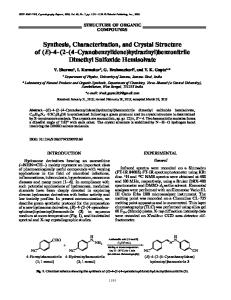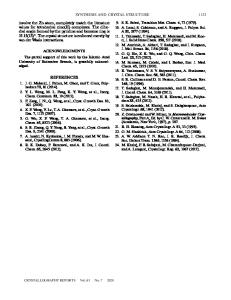SYNTHESIS AND CRYSTAL STRUCTURE OF THE Ni(II) COMPLEX WITH (4 Z )-4-[(2-DIETHYLAMINOETHYLAMINO)METHYLENE]- 5-METHYL-2-PH
- PDF / 1,102,384 Bytes
- 7 Pages / 612 x 792 pts (letter) Page_size
- 102 Downloads / 243 Views
SYNTHESIS AND CRYSTAL STRUCTURE OF THE Ni(II) COMPLEX WITH (4Z)-4-[(2-DIETHYLAMINOETHYLAMINO)METHYLENE]5-METHYL-2-PHENYLPYRAZOLE-3-ONE A. S. Burlov1*, V. G. Vlasenko2, Yu. V. Koshchienko1, A. I. Uraev1, E. V. Korshunova1, M. S. Milutka1, D. A. Garnovskii3, I. V. Linko4, and V. N. Khrustalev4,5
The Ni(II) complex based on (4Z)-4-[(2-diethylaminoethylamino)methylene]-5-methyl-2-phenylpyrazole3-one (HL), being the condensation product of 5-hydroxy-3-methyl-1-phenylpyrazole-4-carbaldehyde with N,N-diethylethylenediamine, is synthesized. By the elemental analysis and IR spectroscopy it is found that the nickel complex has the composition Ni(L)CH3COO⋅CH3OH⋅H2O. The crystal and molecular structures of the complex are determined by single crystal X-ray diffraction (XRD). From the XRD data it follows that the monochelate Ni(II) complex has a distorted octahedral structure due to bonds with a monodentate acetate anion and methanol and water molecules. DOI: 10.1134/S0022476620100121 Keywords: metal complexes, magnetic properties, single crystal X-ray diffraction analysis, IR and 1 H NMR spectroscopy.
INTRODUCTION Metal complexes with pyrazolone moieties attract the attention of researchers due to a wide range of their practically useful properties [1, 2]. Pyrazolone moieties are contained in some biologically active natural alkaloids and pharmaceuticals with antituberculous [3], antidiabetic [4, 5], antineoplastic [6-8], antioxidant [9, 10], antibacterial [6, 9, 11], and antimicrobial properties [12-14]. Recently, many investigations have been made of pyrazolones (mainly those with hydrazone, semicarbazone, and thiosemicarbazone moieties) as photochromic materials that can be potentially used, for example, in high-density information storage systems and optical switching devices [15-18] and as photoluminescent materials [19-23]. This work reports the results of the synthesis and study of the structures and properties of new compounds: (4Z)-4[(2-diethylaminoethylamino)methylene]-5-methyl-2-phenylpyrazole-3-one (HL), being the condensation product of 5-hydroxy-3-methyl-1-phenylpyrazole-4-carbaldehyde with N,N-diethylethylenediamine, and its nickel(II) complex.
1
Research Institute of Physical and Organic Chemistry, Southern Federal University, Rostov-on-Don, Russia; *[email protected]. 2Research Institute of Physics, Southern Federal University, Rostov-on-Don, Russia. 3Southern Scientific Center, Russian Academy of Sciences, Rostov-on-Don, Russia. 4People’s Friendship University of Russia, Moscow, Russia. 5Zelinsky Institute of Organic Chemistry, Russian Academy of Sciences, Moscow, Russia. Original article submitted March 26, 2020; revised May 6, 2020; accepted May 6, 2020. 0022-4766/20/6110-1599 © 2020 by Pleiades Publishing, Ltd.
1599
EXPERIMENTAL In the work, we used commercially available (all from Alfa Aesar) N,N-diethylethylenediamine (98%, CAS: 10036-7), nickel acetate tetrahydrate (99+%, CAS: 6018-89-9), and solvents: chloroform (99.8+%, CAS: 67-66-3), methylene chloride (99.8%, CAS: 75-09-2), and methanol
Data Loading...











